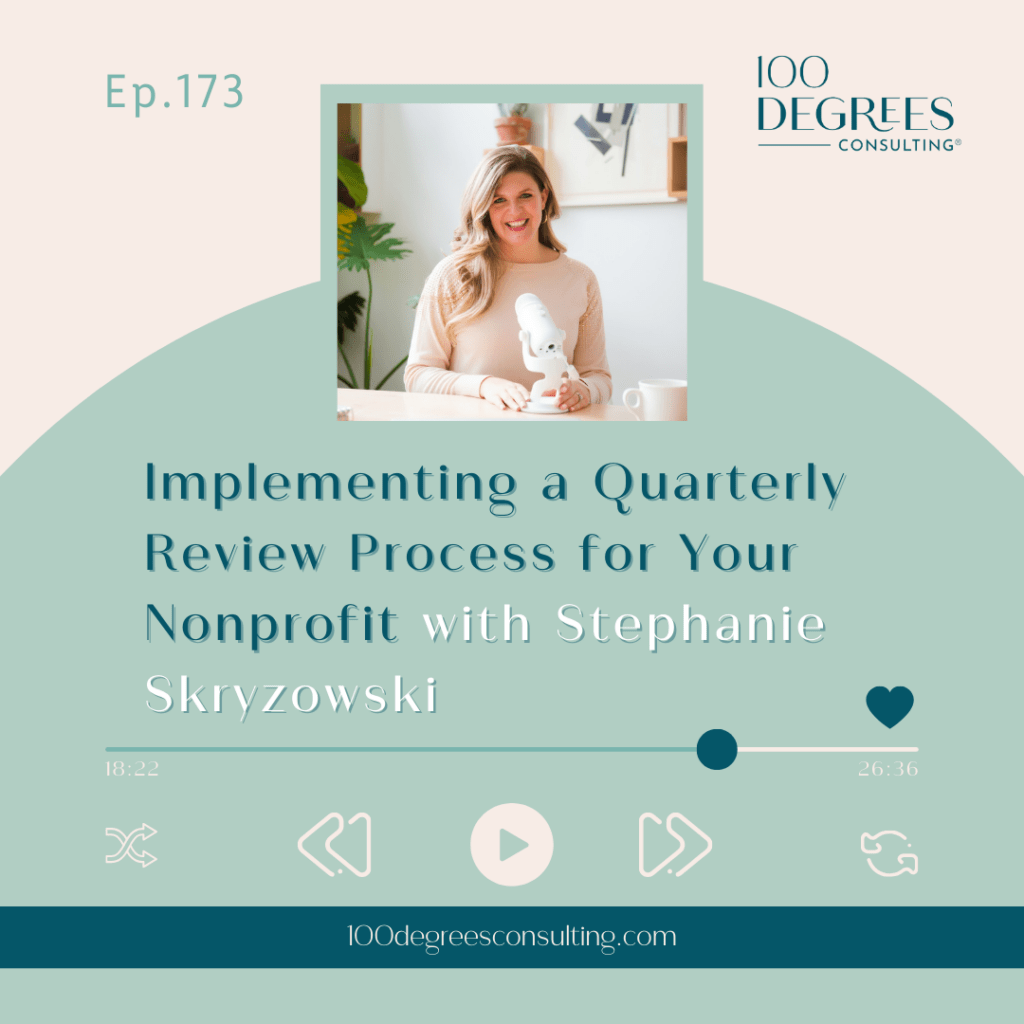Episode 50: How to Efficiently Share Financial Info with Your Team
Transcript Episode 50
Stephanie Skryzowski
Welcome to the 100 degrees of entrepreneurship podcast the show for purpose driven entrepreneurs who want to get inspired to step outside of your comfort zone, expand it to your purpose and grow your business in a big way. I’m your host, Stephanie Skryzowski, a globe trotting CFO whose mission is to empower leaders to better understand their numbers, to grow their impact and their income. Let’s dive in!
Hey there, welcome back to 100 degrees of entrepreneurship. I’m Stephanie. And I’m excited that you’re here today, because we are talking about transparency, how to share financial information the right way with the right people at the right time.
So, you may have listened to our episode with Ellen Yin. We talked about why and how she shares her business income with her audience. And so we talked about a lot of the benefits that she sees around sharing her financials. Literally, how much money she makes, how much money she spends with her audience.
And so I want to take that a little bit further today. Because, as your business gets bigger, you may feel like you should be sharing your financials with your team. Or maybe you feel like you shouldn’t be sharing your financials with your team.
But we’re going to talk a little bit today about the who, what, when, where, why, and sharing your numbers with different people in your business and in your organization.
So I think about this in, you know, in kind of the context of your personal finances, right? Even if you’re not the one in your household, who pays the electric bill, or checks your bank statements, or transfers the money into savings. You’re still invested in the financial health of the family, right? Of the unit, how money is spent, affects you.
And so you’re conscious of the impact that on your financials that your actions will have, right? If you spend $500, on a new pair of suede boots, that’s going to impact your financial health of your family in some way, shape, or form.
For some that might be devastating for some that’s a drop in the bucket, maybe you’re somewhere in the middle. Anyway, that impacts you, right. And so that same mentality really needs to apply in the business space and the nonprofit world as well, right?
Because oftentimes, your team is so far removed from the budget from the balance sheet from the profit and loss, that they have no idea how the business is doing.
And they’re spending all their time and energy really serving your clients or doing the work that you do. But there’s not a whole lot of time to dig deeper and figure out how the business is doing. So, it’s our responsibility as the leader to be transparent and share at least some pieces of how healthy the business is financially. Because what I have found, especially I found, I’ve done some research and found this in the nonprofit space, but I know that it applies to businesses as well.
When you are more transparent with your financials, you’re going to get a greater sense of ownership from the team, right? The team is going to feel like, “oh man, I’m a part of this. I can help make this better,” they’re going to have a greater sense of ownership.
And when they have a greater sense of ownership, they’re going to be more engaged, right? They’re going to participate more, they’re going to want to come up with new ideas to help the business make more money and to serve your clients in a new way when they are more when they have a greater sense of ownership.
So, there’s only a benefit in sharing your numbers. But we just want to make sure or doing it the right way, right? Like just sending out your P&L, your profit and loss and your balance sheet in Excel sheets to your entire team via email with no context around it. That’s probably a terrible idea. No, that is a terrible idea. Don’t do that!
But sharing the concept. Sharing, you know, a dashboard or some high level numbers with your team is very, very beneficial.
Okay, so let’s go through the who, what, when? Maybe not where, who, what, when and how.
Let’s go through the who, what, when and how of sharing your numbers.
So, who? Who are we talking about here? Well, Ellen, Ellen Yin in Episode 44. She shares it with everybody, right? She shares certain pieces of her financial health to literally her entire audience, her podcast audience, her team, her social media audience. Literally everyone.
So that is your decision. You do not have to share your information with everyone. I don’t. I feel a little bit uncomfortable with that honestly. So I don’t want to share with everyone but I do share some information with my leadership team.
Think about who would benefit most from having information on your finances. And again, this is not like oh, here’s my personal checking account number. No, this is talking about revenue, expenses, profit, etc.
So think about the who, who does it make sense for you to share some information with. We’re gonna talk about what information in a second, right? So don’t freak out that you need to send your bank balance to your entire team. But think about the who first.
Okay, so for me, my who is my leadership team, it’s my client success manager and my operations manager. They are more in the know, on our financials than anybody else on the team. Obviously, I see everything, but they know they don’t see everything, but they do know some pieces of it. Think about your who.
Next, think about what, so what are we actually going to share, if you want to go for full transparency and share your entire profit and loss statement? Go for it. There’s absolutely nothing wrong with that and it could be beneficial.
However, it may also have a lot of information that they just your whole team, like just doesn’t need to know, right? So when we’re thinking about the what, I would say keep it high level, right?
So and think about details that are relevant to the who, right, so whichever particular people on your team, or whatever that looks like, think about what details are going to be relevant for them. And so I, for my team, I think about our revenue goals, we have a monthly recurring revenue goal, and they know where we are compared to that goal, right?
So, if you have a goal of like, okay, $10,000 a month, I want to be our recurring revenue goal. And we’re at $8,000 a month, that might be helpful for your team to know that so they can help, you know, help make that goal, right? So that’s what my team knows.
On the expense side of things. One thing that I’ve worked on with one particular client that I’m thinking of is like this year, each of their department heads put together their budget for the year.
Now they know what their expenses are. And so they’re going to get reports every single month that show their expenses for the you know, budget versus actual, their budgeted expenses, and how much they’ve actually spent. They can see that piece of the expenses, as well as the revenue side of things, the sales.
And so thinking about the what, and just remembering that that doesn’t have to be, you don’t have to share everything, right. So you could start with just a revenue goal. Or you can start with just their little piece of the expenses and grow from there or not, right?
So think about the what, what does that look like for you and your team.
COMMERCIAL BREAK: You hear me talk all the time about how important it is to know your numbers as a business owner. But you may be thinking, well, how in the world do I do that? Where do I even begin? So, I have a free resource for you. The profit playbook is an amazing template that you spend about 15 minutes getting it all set up. And you can literally see into the future of your business revenue, expenses, cash flow, just like a crystal ball. It is a huge resource that will absolutely help you create a roadmap to reach your goals in your business. It is for free, over at 100degreesconsulting.com/profit
So, when? Consistency is key here, my friend, so when are we sharing this information? So you can share it.
I like kind of, you know, an annual goal setting meeting as a team. We’re going to talk about like, “okay, everybody, our goal this year is $500,000 in revenue. And here’s how we plan on getting there. And let’s all get on board with this giddy up. Let’s do it!” Right?
I think at the beginning of the year is a great time to just set your annual goal. But if that is the only time you talk about your numbers, and you are not, as the leader, you’re not providing them any updates on like, oh, how are we doing? Are we getting close to that 500,000? Are we really far off, then they’re going to lose interest and engagement really, really quickly.
So it’s important to continue to share this information monthly. If you have a goal that you’re working towards, find a financial goal that you’re working towards, it’s important to share updates on this every single month, right? And I know my friend, because you’re listening to this podcast, and you’re interested in managing your money.
I know that you’re checking in on your financials every single month. So this shouldn’t be too hard for you to share an update of like, okay, our goal was $100,000 this month we hit $105,000. All right, great. Let’s, you know, maybe debrief on what happened. How did we exceed that goal? So your team needs to be updated frequently so that they can continue that engagement because once a year is just not going to do it.
So, how? Now that we’ve gone through the who are we sharing our financials with, we’ve talked about exactly what we’re going to share. Remember, we didn’t say you have to share your entire P&L, you can share different pieces of it that are important and impactful to different members of your team.
And we talked about when to share it like set the goals annually but then check up every single month and continue being consistent and sharing that information. And then finally, how are we sharing this with them? So, I like to do a couple different things.
I mean, honestly, okay. I like to do certain things with clients. And then I do different things with my own business because, you know! Cobblers, children have no shoes situation, right?
So, for my own team, I’m kind of just verbally sharing this in a staff meeting. Or a sorry, a leadership meeting where I’m like, okay, our goal for the year that we’ve all determined together is this, you know, that means our monthly revenue has to be X, and our monthly revenue, actually, last month was Y.
Here’s what we’re going to do, let’s talk about what we’re going to do to, you know, achieve that goal next month, or whatever, you know. So I’m kind of verbally sharing this information with my own leadership team. Now for our clients.
So what I always recommend is using some simple graphs and s in Excel, or in PowerPoints, or wherever you create your graphs and charts, and just kind of keep it simple, but in dashboard format, and so whether that’s breaking down expenses into different categories, and showing where we are in the budget compared to our actuals, or whether that is looking at our revenue growth year over year in a chart format.
Any kind of visual, you know, a visual format makes it super, super easy for anybody who’s looking at the numbers to understand even if they’re not a numbers person and get easily overwhelmed by financial statements.
I like kind of throwing together some nice little graphs and charts and our clients know that if you work with us, we have in our finance workbook, we have a little dashboard tab that has a number of different charts in there as well that are super helpful to really visualize some of these important pieces of data that we like to look at.
So you don’t have to do anything fancy, you could be like me, and just verbally tell your leadership team or your team, what the numbers are, and how they can you know, how they can support and how they can help, or you get fancy and put together a couple charts and graphs.
I really like that, really just keeping it simple. Because, you know, if you just were to send out, you know, your financial statements to your team, do they know what accrued expenses are, or current liabilities?
Probably not, right? And they don’t need to, it’s not important for them to know that information. So taking the extra time to explain it to them, you’re gonna see a lot more head nods rather than heads buried in smartphones. Right? They’re gonna be like, oh, okay, I get this, this makes sense.
So anyway, that’s transparency. That is the who, what, where and when of sharing your financial info with your team, or with whoever you determine that you should. I really encourage you to be transparent about your financials, even if you feel a little bit nervous about it.
Again, you don’t have to share like, here’s my personal bank account login. No, that’s not what I’m talking about here!
I’m talking about sharing some big picture numbers with your team to help breed more ownership and more engagement and your team is really what is going to help you take your business to the next level. And so a more engaged team that is just a win for everybody.
So I would love to hear if you already share your numbers with your team or maybe even bigger. Maybe you’re like Ellen Yin and you share your numbers with the world. I would love to hear about it. Tag me over on Instagram or send me a DM @stephanie.skry. And we can chat all about transparency.
Alright, my friends, I’ll see you next time!
Thanks for listening to the 100 degrees of entrepreneurship podcast. To access our show notes and bonus content, visit 100degreesconsulting.com/podcast. Make sure to snap a screenshot on your phone of this episode and tag me on instagram @stephanie.skry and I’ll be sure to share. Thanks for being here friends, and I’ll see you next time!
Transcript for Episode 50




















